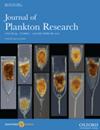有害藻华反复发生的分层近岸生态系统中的浮游植物代谢
IF 2
3区 环境科学与生态学
Q2 MARINE & FRESHWATER BIOLOGY
引用次数: 0
摘要
沿海海洋正在经历其物理和化学性质的变化,这些变化强烈影响浮游生物代谢组合,在某些情况下,有利于有害藻华(HABs)的发生。本文分析了位于地中海海滩的两个近岸采样点(P1和P2)的浮游植物生物量、总初级生产量和净初级生产量(NCP)以及群落呼吸(CR)的变化。在暴露最严重的P1,浮游植物叶绿素普遍较低,而在P2夏季,裸子藻属和亚历山大藻属的甲藻反复爆发,持续10-20天。在开花期间,NCP增加了10倍(>80 mmol O2 m−3 day−1)。相比之下,CR的变化平均仅达到非开花条件下的1.8倍。值得注意的是,尽管NCP:CR比值的提高表明净自养种群增长,但P1和P2的单位生物量产量差异不显著。我们的研究结果表明,尽管夏季条件有利于导致赤潮发生的必要初级生产增强,但驱动高生物量事件的短期动态不是由代谢变化驱动的,而是由一些鞭毛虫物种在营养丰富的近岸环境中微妙的积累过程控制的。本文章由计算机程序翻译,如有差异,请以英文原文为准。
Phytoplankton metabolism in a stratified nearshore ecosystem with recurrent harmful algal blooms (HABs)
The coastal ocean is experiencing changes in its physical and chemical properties that strongly affect planktonic metabolism assemblages and, in some cases, favor the occurrence of harmful algal blooms (HABs). Here we analyze the variations in phytoplankton biomass, gross and net primary production (NCP) as well as community respiration (CR) at two nearshore sampling sites (P1 and P2) located at a Mediterranean beach where high biomass HABs are recurrent. At P1, the most exposed site, phytoplankton chlorophyll was generally low, whereas dinoflagellates outbreaks of the genus Gymnodinium and Alexandrium were recurrent during summer at P2 spanning for 10–20 days. During bloom episodes, NCP increased up to 10-fold (>80 mmol O2 m−3 day−1). Contrastingly, variation in CR only reached an average of 1.8-fold the rates of non-bloom conditions. Remarkably, although the enhanced NCP:CR ratio suggests net autotrophic population growth, production per unit biomass at P1 and P2 was not significantly different. Our results indicate that although summer conditions favor the necessary primary production enhancement leading to HAB occurrences, the short-term dynamics driving high biomass episodes are not driven by metabolic variations but instead are governed by subtle accumulative processes of some flagellate species in the nutrient-rich nearshore environment.
求助全文
通过发布文献求助,成功后即可免费获取论文全文。
去求助
来源期刊

Journal of Plankton Research
生物-海洋学
CiteScore
3.50
自引率
9.50%
发文量
65
审稿时长
1 months
期刊介绍:
Journal of Plankton Research publishes innovative papers that significantly advance the field of plankton research, and in particular, our understanding of plankton dynamics.
 求助内容:
求助内容: 应助结果提醒方式:
应助结果提醒方式:


